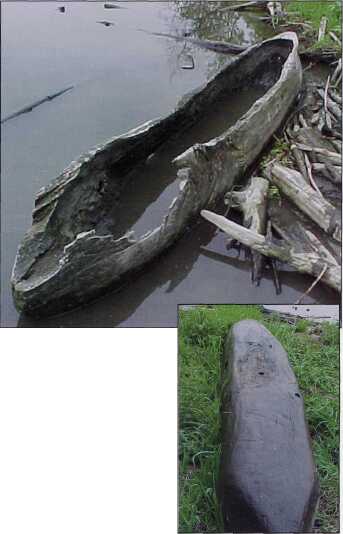Potawatomi or notami?
By Nathan Hall

Illinois State Museum officials believe this dugout canoe, discovered last spring in the backwaters of the Kankakee and Des Plaines rivers, could he more than 250 years old. Photos courtesy Mike Bronson and Mark Walcynzski.
|
Last April, Mike Bronson, an Illinois Department of Natural Resources conservation police officer, saw something peculiar amidst a pile of driftwood while he patrolled by airboat near the junction of the Des Plaines and Kankakee rivers. A 10-foot dugout canoe sat half-submerged in the waters. Sensing the canoe might have some historical importance, Bronson contacted conservation police officer and historian Mark Walcynzski. Walcynzski arrived at the site later that day, and the two removed the canoe from the water and placed it on shore. Walcynzski then made a call to the Dickson Mounds Museum, near Lewistown, to tell authorities on Native American Illinois culture of his find. The museum staff quickly arrived on the site and took the canoe back to their laboratory to be cleaned and further studied.
The canoe's origin and cultural history still remain a mystery, but preliminary observations reveal that it was constructed sometime between 1700 and 1850. The museum staff concluded that the canoe seemed to be crafted from two types of steel hand tools: a flat-blade adze and a circular-bit gouge. Both tools were commonly used during this historic period.
Walcynzski said if the canoe was constructed during this time period it is of particular interest because the Potawatomi Indians are known
|
The canoe's origin and
cultural history still
remain a mystery, but
preliminary observations
reveal that it was
constructed sometime
between 1700 and 1850.
|
to have inhabited the area where the canoe was found from 1774 to 1833.
Kelvin Sampson, a historian at Dickson Mounds Museum, said researchers have found no conclusive evidence to determine the canoe's past. "At this point, there is no real reason to believe that it belonged to the Potawatomi," Sampson said. "The circumstance of the find — in a pile of washed up brush — indicates that it could have come from anywhere upstream. Thus, nothing can be said about its context."
Sampson also noted that the 10-foot-long canoe is relatively small when compared to other known Indian canoes.
In addition, the canoe appears to have what looks like chainsaw marks, and this might shed some light on its origin. "Close examination of these marks might reveal something but even with close
ILLINOIS HERITAGE| 17

examination the mystery may never be solved," Sampson told Illinois Heritage.
Regardless of its past, says Mark Walcynzski, the canoe is still a "very interesting find" in Illinois. It is only the fourth dugout canoe to be discovered
It is only the fourth
dugout canoe to be
discovered in the last
century on Illinois
waterways.
|
in the last century on Illinois waterways.
The first was found in 1931 on the banks of the Kaskaskia River. The second canoe was discovered in 1934 on the Rock River. The third canoe was found in 1994 on the La Moine River.
This latest dugout canoe is currently on display at the Dickson Mounds Museum.
Nathan Hall is senior English student at the University of Illinois at Springfield, and an intern with the Illinois State Historical Society.
18 |ILLINOIS HERITAGE
|

